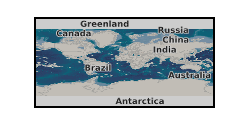Marine environment
Type of resources
Available actions
Topics
Keywords
Contact for the resource
Provided by
Years
Formats
Update frequencies
-

The NERC-funded QICS controlled CO2 release experiment (located offshore Oban, Scotland) mimics the formation of a new CO2 seep in the marine environment. At the site, CO2 is injected at an onshore wellhead, and a stainless steel pipe transports the CO2 under the seabed. Approximately 350 m offshore, the CO2 is released through a perforated screen into the 12 metres of overlying marine sediment, which is at approximately 10 metres water depth. During spring/summer 2012, 4.2 tonnes of CO2 was released at the QICS experimental site. In order to establish stakeholder views on the research priorities for the site, consultations for three 'audiences' were performed via online questionnaires. These 'audiences' were: 1. QICS research community: Researchers actively involved in the QICS project were asked to complete an online questionnaire. The questionnaire aimed to gather participants' reflections of the QICS CO2 injection experiment in Summer 2012, and also to consult on the scientific priorities for possible future activity at the site. 2. CCS (storage) research community: The international CCS research community (specifically, researchers working on aspects of CO2 storage) were consulted via an online questionnaire distributed by the IEAGHG storage network mailing list in June 2013. The survey aimed to gather their reflections of the QICS project, and to consult on the scientific priorities for possible future activity at the site. The survey had 24 respondents with a broad range of expertise and representing both industry and research organisations from 10 countries. 3. Technology industry: Technology industries were consulted via an online questionnaire. The survey aimed to gather consult on the scientific priorities for science and technology development at possible future activity at the site, and also to scope potential interest from technology developers. For each of these consultations there is a report (presenting a synthesis of the survey responses) and also the dataset for all three surveys. All of these files are confidential. Grant number: UKCCSRC-C1-31.
-

This report has been superseded by the paper: https://www.sciencedirect.com/science/article/pii/S1750583617301081. Grant number: UKCCSRC-C1-31. The NERC-funded QICS controlled CO2 release experiment (located offshore Oban, Scotland) mimics the formation of a new CO2 seep in the marine environment. At the site, CO2 is injected at an onshore well head, and a stainless steel pipe transports the CO2 under the seabed. Approximately 350 m offshore, the CO2 is released through a perforated screen into the 12 metres of overlying marine sediment, which is at approximately 10 metres water depth. During spring/summer 2012, 4.2 tonnes of CO2 was released at the QICS experimental site. A key element of risk assessment for the subsurface storage of CO2 is the monitoring of leaks from the subsurface in to the marine or terrestrial environments via sediments and soils. Chemical 'fingerprinting' of injected CO2 is widely considered a low cost, highly effective monitoring option, since effective application of tracers in CCS could provide information on (i) the movement, interaction and fate of injected CO2 in the subsurface and (ii) the detection (and quantification) of CO2 that has leaked from the storage complex to the surface. There is a need to develop geochemical techniques to differentiate between CO2 from natural processes, and the QICS site may provide excellent opportunity to trial geochemical tracers. This work aims to determine which chemical tracers are most suitable for CO2 tracing at the QICS facility and the research questions that tracer application can address. As such, this report includes: i. A review of current potential chemical tracers for CCS and their applications. ii. An analysis and comparison of costs, availability, environmental impact and detection limits for potential tracers. iii. An assessment of the above in the context of QICS (i.e: considering the CO2 will be released from the seabed (having passed from dense to gas phase), and having passed through water saturated sediment of the seabed, and into the water column. iv. An overview of the legal considerations for tracers in the UK. v. The injection method for tracers at the QICS site. vi. Required strategies for sampling the selected tracer. vii. Identify knowledge gaps in tracer studies which experiments at the QICS site could address.
 NERC Data Catalogue Service
NERC Data Catalogue Service